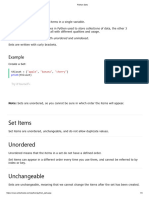0 ratings0% found this document useful (0 votes)
290 viewsPython Sets
Sets in Python are unordered collections of unique elements that can be created using the built-in set() function. Sets can contain different data types and have optimized methods for checking membership. Sets cannot store mutable elements like lists or dictionaries. The document demonstrates how to create empty and populated sets from strings, objects, and lists.
Uploaded by
Gourav KatarukaCopyright
© © All Rights Reserved
Available Formats
Download as DOCX, PDF, TXT or read online on Scribd
0 ratings0% found this document useful (0 votes)
290 viewsPython Sets
Sets in Python are unordered collections of unique elements that can be created using the built-in set() function. Sets can contain different data types and have optimized methods for checking membership. Sets cannot store mutable elements like lists or dictionaries. The document demonstrates how to create empty and populated sets from strings, objects, and lists.
Uploaded by
Gourav KatarukaCopyright
© © All Rights Reserved
Available Formats
Download as DOCX, PDF, TXT or read online on Scribd
You are on page 1/ 2
Python Sets
In Python, Set is an unordered collection of data type that is iterable, mutable
and has no duplicate elements. The order of elements in a set is undefined
though it may consist of various elements.
The major advantage of using a set, as opposed to a list, is that it has a highly
optimized method for checking whether a specific element is contained in the
set.
Creating a Set
Sets can be created by using the built-in set() function with an iterable object or
a sequence by placing the sequence inside curly braces, separated by ‘comma’.
Note – A set cannot have mutable elements like a list, set or dictionary, as its
elements.
# Python program to demonstrate
# Creation of Set in Python
# Creating a Set
set1 = set()
print("Intial blank Set: ")
print(set1)
# Creating a Set with
# the use of a String
set1 = set("GeeksForGeeks")
print("\nSet with the use of String: ")
print(set1)
# Creating a Set with
# the use of Constructor
# (Using object to Store String)
String = 'GeeksForGeeks'
set1 = set(String)
print("\nSet with the use of an Object: " )
print(set1)
# Creating a Set with
# the use of a List
set1 = set(["Geeks", "For", "Geeks"])
print("\nSet with the use of List: ")
print(set1)
Output:
Intial blank Set:
set()
Set with the use of String:
{'e', 'r', 'k', 'o', 'G', 's', 'F'}
Set with the use of an Object:
{'r', 'o', 'e', 'F', 's', 'k', 'G'}
Set with the use of List:
{'Geeks', 'For'}
You might also like
- Sets in Python Creating Accessing and MoreNo ratings yetSets in Python Creating Accessing and More9 pages
- WINSEM2024-25_CBS1011_ETH_VL2024250505139_2025-02-13_Reference-Material-I (1)No ratings yetWINSEM2024-25_CBS1011_ETH_VL2024250505139_2025-02-13_Reference-Material-I (1)16 pages
- Unit III Notes-Python Programming(BCA614)No ratings yetUnit III Notes-Python Programming(BCA614)23 pages
- Python Set and Booleans With Syntax and ExamplesNo ratings yetPython Set and Booleans With Syntax and Examples25 pages
- Sets in Python Accessing Updating and MoreNo ratings yetSets in Python Accessing Updating and More10 pages
- Example 3-9: Example 3-9. Mappingproxytype Builds A Read-Only Mappingproxy Instance From A DictNo ratings yetExample 3-9: Example 3-9. Mappingproxytype Builds A Read-Only Mappingproxy Instance From A Dict5 pages
- Example 1: Using Curly Braces: "Monday" "Tuesday" "Wednesday" "Thursday" "Friday" "Satu Rday" "Sunday"No ratings yetExample 1: Using Curly Braces: "Monday" "Tuesday" "Wednesday" "Thursday" "Friday" "Satu Rday" "Sunday"21 pages
- A2SV Python Track - DS Basics 2 - Sets and DictionariesNo ratings yetA2SV Python Track - DS Basics 2 - Sets and Dictionaries40 pages
- L6 - L7List - Set - Tuple - Dictionaries - Type ConversionNo ratings yetL6 - L7List - Set - Tuple - Dictionaries - Type Conversion95 pages
- Introduction To Tuples: #Creates An Empty TupleNo ratings yetIntroduction To Tuples: #Creates An Empty Tuple22 pages



























































